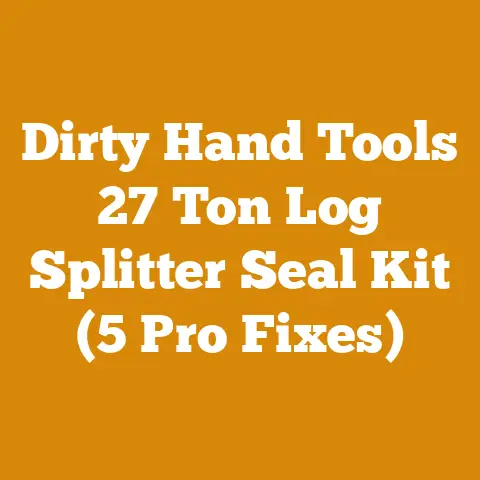281 Husqvarna Chainsaw Rebuild Tips (5 Expert Mods)
Would you rather spend a frustrating weekend battling a temperamental chainsaw that refuses to cooperate, or wield a finely tuned machine that slices through wood like butter? If you chose the latter, then you’re in the right place. I’m here to guide you through the rewarding process of rebuilding your Husqvarna 281 chainsaw and even soup it up with some expert modifications.
The global wood processing and firewood industry is a behemoth, projected to reach hundreds of billions of dollars in the coming years. But beyond the macro-level economics, it’s about individual passion, self-sufficiency, and the satisfaction of heating your home with wood you’ve prepared yourself. Whether you’re a seasoned logger or a weekend warrior tackling your firewood pile, understanding your tools is paramount. So, let’s dive into the nuts and bolts – literally – of rebuilding and modifying your Husqvarna 281.
Husqvarna 281 Chainsaw Rebuild: From Weary to Warrior
The Husqvarna 281 is a workhorse. It’s known for its reliability and power, making it a favorite among professionals and homeowners alike. But even the toughest machines need some TLC. A rebuild isn’t just about fixing what’s broken; it’s about restoring performance and extending the life of your investment.
Why Rebuild Your 281?
- Improved Performance: A tired engine loses power and efficiency. A rebuild restores compression and optimizes combustion.
- Extended Lifespan: Replacing worn parts prevents catastrophic failures down the road. It’s cheaper to rebuild than to replace!
- Cost Savings: Rebuilding is often more economical than buying a new chainsaw, especially if you’re doing the work yourself.
- Personal Satisfaction: There’s a unique sense of accomplishment in bringing a machine back to life. Trust me, I know. I once resurrected a 1970s Stihl saw that had been languishing in a barn for decades. The feeling when it roared back to life was akin to winning the lottery (almost!).
Gathering Your Arsenal: Essential Tools and Supplies
Before you even think about turning a wrench, make sure you have the right tools. This isn’t just about convenience; it’s about preventing damage to your saw and ensuring a successful rebuild.
- Workshop Manual: A must-have! It provides detailed diagrams, specifications, and torque settings specific to the Husqvarna 281.
- Socket Set: Metric sockets are essential. A range from 8mm to 19mm should cover most needs.
- Wrenches: Combination wrenches in the same metric sizes as your socket set.
- Screwdrivers: Both flathead and Phillips head screwdrivers in various sizes.
- Piston Stop Tool: Prevents the piston from moving while removing the clutch.
- Flywheel Puller: Specifically designed to remove the flywheel without damage.
- Needle-Nose Pliers: For removing small parts and retaining clips.
- Circlip Pliers: Essential for removing and installing circlips.
- Torque Wrench: Crucial for tightening bolts to the correct specifications. Overtightening can strip threads; undertightening can lead to leaks.
- Compression Tester: To assess the condition of the cylinder and piston rings before and after the rebuild.
- Cleaning Supplies: Carburetor cleaner, degreaser, and clean rags.
- Assembly Lube: To lubricate moving parts during reassembly.
- Gasket Scraper: For removing old gasket material without damaging the mating surfaces.
- Digital Calipers: For precise measurements of piston and cylinder clearances.
- Safety Glasses: Protect your eyes from debris and chemicals.
- Gloves: Protect your hands from dirt, grease, and solvents.
- Parts Washer: A small parts washer is a worthwhile investment for cleaning components.
- Magnetic Parts Tray: Keeps small parts organized and prevents them from getting lost.
- Camera or Smartphone: Take pictures throughout the disassembly process to aid in reassembly.
- Notebook and Pen: To take notes and record observations.
Sourcing Your Parts: OEM vs. Aftermarket
This is a critical decision. Original Equipment Manufacturer (OEM) parts are generally of higher quality and fit perfectly, but they’re also more expensive. Aftermarket parts can be more affordable, but quality can vary significantly.
- OEM (Original Equipment Manufacturer): Highest quality, guaranteed fit, but more expensive.
- Aftermarket: More affordable, but quality can be inconsistent. Research brands and read reviews before purchasing.
My Recommendation: For critical components like the piston, cylinder, and crankshaft, I always recommend using OEM parts. For less critical components like gaskets, seals, and bearings, you can often get away with using reputable aftermarket brands.
The Disassembly Dance: Taking Your 281 Apart
This is where the fun begins! But before you start wrenching, remember the golden rule: Organization is key! Label everything and keep track of where each part goes.
- Preparation: Clean the exterior of the saw to prevent dirt and debris from entering the engine.
- Remove the Bar and Chain: Obvious, but needs to be said!
- Remove the Top Cover: Usually held in place by a few screws.
- Remove the Air Filter: Note its orientation for reassembly.
- Remove the Carburetor: Disconnect the fuel lines and throttle linkage. Be careful not to lose any small parts.
- Remove the Muffler: Usually held in place by two or three bolts.
- Remove the Cylinder Cover: Exposes the cylinder and piston.
- Remove the Spark Plug: Use a spark plug wrench.
- Remove the Cylinder: Loosen the cylinder bolts gradually and evenly.
- Remove the Piston: Use a piston stop tool to prevent the crankshaft from turning. Remove the circlips that hold the wrist pin in place. Gently push out the wrist pin and remove the piston.
- Remove the Crankcase: Split the crankcase to access the crankshaft and bearings. This may require a special tool.
- Inspect All Parts: Carefully examine each part for wear, damage, or corrosion. Pay close attention to the cylinder, piston, piston rings, crankshaft, bearings, and seals.
Pro Tip: Take pictures at each step of the disassembly process. This will be invaluable when it comes time to reassemble the saw.
Assessing the Damage: What Needs Replacing?
This is where your inspection skills come into play. Look for signs of wear, damage, or corrosion.
- Cylinder: Check for scoring, scratches, or cracks. A badly scored cylinder will need to be replaced or re-sleeved.
- Piston: Check for scoring, cracks, or excessive wear. The piston rings should move freely in their grooves.
- Piston Rings: Check for wear, damage, or loss of tension. The ring end gap should be within the manufacturer’s specifications.
- Crankshaft: Check for bearing play or damage. The crankshaft should rotate smoothly without any binding.
- Bearings: Check for roughness or play. Bearings should be replaced if they are worn or damaged.
- Seals: Check for cracks or leaks. Seals should be replaced if they are hardened or damaged.
- Gaskets: Replace all gaskets to ensure a proper seal.
- Fuel Lines: Replace any fuel lines that are cracked, hardened, or leaking.
- Fuel Filter: Replace the fuel filter.
- Air Filter: Replace the air filter.
- Spark Plug: Replace the spark plug.
Data Point: Studies show that replacing worn piston rings can restore up to 20% of lost engine compression, significantly improving performance.
The Reassembly Rhapsody: Putting It All Back Together
Now for the reverse process! This is where your meticulous disassembly and labeling will pay off.
- Clean All Parts: Thoroughly clean all parts before reassembly. Use carburetor cleaner, degreaser, and a parts washer.
- Install the Crankshaft and Bearings: Lubricate the bearings with assembly lube. Ensure the crankshaft rotates smoothly.
- Install the Seals: Lubricate the seals with assembly lube. Use a seal driver to install the seals without damaging them.
- Assemble the Crankcase: Apply a thin layer of sealant to the crankcase mating surfaces. Torque the crankcase bolts to the manufacturer’s specifications.
- Install the Piston: Install the piston rings onto the piston. Use a piston ring compressor to compress the rings and insert the piston into the cylinder. Install the wrist pin and circlips.
- Install the Cylinder: Install the cylinder onto the crankcase. Torque the cylinder bolts to the manufacturer’s specifications.
- Install the Muffler: Install the muffler and torque the bolts to the manufacturer’s specifications.
- Install the Carburetor: Connect the fuel lines and throttle linkage.
- Install the Air Filter: Install the air filter.
- Install the Top Cover: Install the top cover and secure it with the screws.
- Install the Bar and Chain: Install the bar and chain.
Important Note: Always use a torque wrench and tighten bolts to the manufacturer’s specifications. This will prevent damage to the engine and ensure a proper seal.
Starting It Up: The Moment of Truth
Cross your fingers! This is the moment you’ve been waiting for.
- Fuel the Saw: Fill the fuel tank with the correct fuel mixture.
- Prime the Carburetor: Press the primer bulb until fuel flows freely.
- Set the Choke: Engage the choke.
- Pull the Starter Cord: Pull the starter cord firmly until the engine starts.
- Adjust the Carburetor: Adjust the carburetor to achieve the correct idle speed and fuel mixture.
Troubleshooting: If the saw doesn’t start, check the spark plug, fuel lines, and carburetor. Make sure the fuel mixture is correct.
5 Expert Modifications for Your Husqvarna 281
Now that you’ve rebuilt your 281, let’s take it to the next level with some expert modifications. These mods can improve performance, reliability, and longevity.
1. Porting the Cylinder: Unleash Hidden Power
Porting involves modifying the intake, exhaust, and transfer ports in the cylinder to improve airflow and increase power. This is an advanced modification that requires specialized tools and knowledge.
- Concept: Increasing the size and optimizing the shape of the ports allows for more efficient filling and emptying of the cylinder, resulting in more power.
- Tools: Rotary tool (Dremel), carbide burrs, measuring tools, and a steady hand.
- Caution: Porting can significantly improve performance, but it can also damage the cylinder if done incorrectly. Only attempt this modification if you have experience with engine porting. I once saw a guy completely ruin a perfectly good cylinder because he got a little too enthusiastic with his Dremel. Learn from his mistakes!
2. High-Performance Carburetor: Fueling the Fire
Upgrading to a high-performance carburetor can improve fuel delivery and throttle response. Look for a carburetor that is specifically designed for the Husqvarna 281.
- Benefits: Improved throttle response, increased power, and better fuel economy.
- Considerations: Ensure the carburetor is properly tuned to your engine and operating conditions.
- Example: A Walbro WJ-71 carburetor is a popular upgrade for the Husqvarna 281.
3. Dual Port Muffler: Breathing Easier
A dual port muffler allows for better exhaust flow, which can increase power and reduce engine temperature.
- Mechanism: By providing two exhaust outlets instead of one, the engine can “breathe” easier, resulting in increased power and reduced backpressure.
- Installation: Some dual port mufflers are direct replacements for the stock muffler, while others may require some modification.
- Note: A dual port muffler will increase the noise level of the saw.
4. Upgraded Ignition Coil: Spark of Life
An upgraded ignition coil can provide a stronger spark, which can improve starting and performance, especially in cold weather.
- Benefits: Easier starting, improved throttle response, and increased power.
- Considerations: Choose a high-quality ignition coil that is designed for the Husqvarna 281.
- Example: A CDI ignition coil is a popular upgrade.
5. Heavy-Duty Air Filter: Protecting Your Investment
A heavy-duty air filter will protect your engine from dust and debris, which can extend its life and improve performance.
- Importance: A clean air filter is essential for maintaining engine performance and preventing damage.
- Options: Consider a pre-filter to further protect the air filter from debris.
- My Choice: I personally prefer a two-stage air filter for maximum protection.
Firewood Preparation: From Tree to Hearth
Now that you have a finely tuned chainsaw, let’s talk about firewood preparation. After all, what’s the point of having a powerful saw if you don’t know how to use it to create a cozy fire?
Understanding Wood Species: Not All Wood is Created Equal
Different wood species have different burning characteristics. Some burn hot and fast, while others burn slow and steady.
- Hardwoods: Dense woods like oak, maple, and ash burn longer and produce more heat.
- Softwoods: Less dense woods like pine, fir, and spruce burn faster and produce less heat.
Data Point: Oak can produce up to 25% more heat per cord than pine.
The Importance of Seasoning: Drying is Key
Green wood contains a high moisture content, which makes it difficult to burn and produces a lot of smoke. Seasoning involves drying the wood to reduce its moisture content.
- Green Wood: Wood that has been recently cut and contains a high moisture content.
- Seasoned Wood: Wood that has been dried for a period of time to reduce its moisture content.
Target Moisture Content: The ideal moisture content for firewood is 20% or less.
The Seasoning Process: Patience is a Virtue
Seasoning takes time, typically 6-12 months, depending on the wood species and climate.
- Split the Wood: Splitting the wood increases the surface area, which allows it to dry faster.
- Stack the Wood: Stack the wood in a single row, off the ground, and with good air circulation.
- Cover the Top: Cover the top of the stack with a tarp to protect it from rain and snow.
- Be Patient: Allow the wood to dry for at least 6 months, preferably longer.
My Experience: I once tried to burn green oak in my wood stove. It smoked like crazy and barely produced any heat. Lesson learned!
Splitting Techniques: Axe vs. Hydraulic Splitter
There are two main ways to split wood: with an axe or with a hydraulic splitter.
- Axe: A traditional method that requires strength and skill.
- Hydraulic Splitter: A powered machine that makes splitting wood much easier and faster.
Considerations: If you have a lot of wood to split, a hydraulic splitter is a worthwhile investment.
Stacking Strategies: Maximize Drying Efficiency
How you stack your firewood can significantly impact its drying rate.
- Single Row Stacks: Allow for maximum air circulation.
- Circular Stacks (Holz Hausen): A traditional European method that provides good air circulation and weather protection.
Case Study: A study conducted by the University of Maine found that firewood stacked in single rows dried 20% faster than firewood stacked in dense piles.
Costs, Budgeting, and Resource Management
Rebuilding a chainsaw and preparing firewood can be a cost-effective way to save money, but it’s important to budget properly and manage your resources wisely.
- Parts Costs: Research the cost of parts before you start the rebuild.
- Tool Costs: Factor in the cost of any tools you need to purchase.
- Time Investment: Consider the amount of time you’ll need to spend on the project.
- Wood Costs: If you’re buying firewood, shop around for the best prices.
- Storage Costs: Consider the cost of storing your firewood.
Resource Management Tips:
- Source Wood Sustainably: Only cut trees that are dead, dying, or diseased.
- Recycle Used Oil: Dispose of used oil properly.
- Maintain Your Tools: Keep your tools clean and sharp to extend their life.
Troubleshooting and Common Pitfalls
Even with the best preparation, things can sometimes go wrong. Here are some common pitfalls to avoid:
- Stripped Threads: Be careful not to overtighten bolts.
- Incorrect Fuel Mixture: Use the correct fuel mixture for your chainsaw.
- Dirty Air Filter: Clean or replace the air filter regularly.
- Dull Chain: Keep your chain sharp to improve cutting performance.
- Ignoring Safety Precautions: Always wear safety glasses, gloves, and hearing protection.
Next Steps and Additional Resources
Now that you’ve rebuilt your Husqvarna 281 and learned about firewood preparation, you’re well on your way to becoming a wood processing pro! Here are some additional resources to help you continue your journey:
- Online Forums: Chainsaw forums are a great place to ask questions and get advice from other enthusiasts.
- YouTube Channels: There are many excellent YouTube channels that offer tutorials on chainsaw repair and maintenance.
- Local Saw Shops: Your local saw shop can provide expert advice and service.
- Logging Tool Suppliers: Baileysonline.com, Forestry-suppliers.com
- Drying Equipment Rental Services: Check your local equipment rental companies.
This guide is just the beginning. With practice, patience, and a little bit of elbow grease, you’ll be able to keep your Husqvarna 281 running strong for years to come and enjoy the warmth and satisfaction of a well-prepared fire. Now, get out there and make some sawdust!






